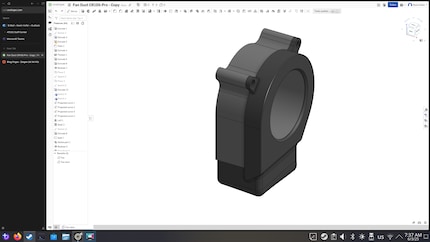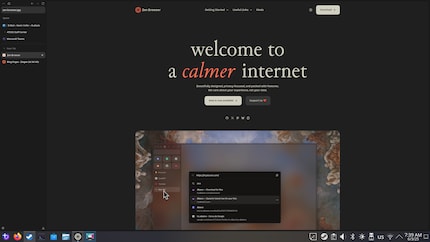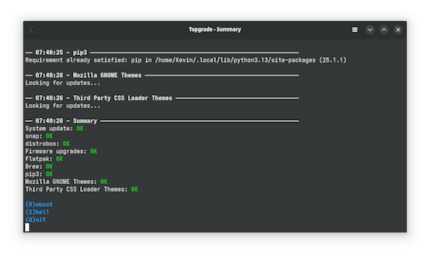
Background information
Switching to Linux: not even that hard
by Kevin Hofer

As an experiment, I turned my back on Windows for a month and tried out Linux distribution Bazzite. After just a few days, I knew there was no going back from the open-source operating system.
«That wasn’t too hard,» was my conclusion after switching to Linux. Fast forward one month and I still feel the same way. I don’t miss Windows one bit. In fact, I don’t want it back, in spite of the fact that there are a few issues. These are the six main reasons why I’m sticking with Linux.
One problem was that Fusion, my favourite CAD, doesn’t run under Linux. But thanks to the Digitec Galaxus Community, I soon found an alternative. At least for the time being, I’m designing my models for 3D printing with Onshape. It basically works in the same way as Fusion, but runs in the browser. In the future, however, I’d like to switch to Blender because it runs natively on Linux and is also open source.

Thanks to this solution, I’m no longer missing anything with Linux. Unfortunately, it was not only the lack of programs that didn’t run smoothly during my first month with the operating system.
One issue involved the game reviews I sometimes write for Digitec Galaxus. I’m generally given pre-release access to the games, which may also include non-optimal graphics card drivers. This has hardly ever been a problem under Windows so far. But under Linux, there were several crashes with Lost Records: Bloom & Rage and Clair Obscur: Expedition 33. Given that the former is the second part of a game already released in February, the drivers should’ve been optimal. Nevertheless, the game crashed several times. My new operating system clearly still has room for improvement here.
I’ve also repeatedly come across other minor problems. At the beginning, I was unable to access my Wi-Fi for a day – despite entering the correct password and rebooting several times. In the end, it worked with a hotspot from my smartphone, which was obviously also connected to my Wi-Fi. The following day, everything was running smoothly again. To this day, I’ve no idea what went wrong.
Another problem, not related to Linux as such, was caused by Firefox. It made me lose the ability to scroll on certain homepages. As a result, I was unable to view the content of those pages, which is why I switched to the Zen browser.

Apart from the games, I didn’t experience any crashes, and everything has run smoothly so far. I also get the impression that Linux runs more efficiently than Windows. This is mainly due to its lower hardware requirements. Bazzite is simply leaner than overloaded Windows.
For example, I feel that programs start a little faster and work more efficiently. This is particularly noticeable when I’m editing photos in Darktable. However, this is probably not only due to Linux, but also to the program itself, which is more resource-efficient than Lightroom.
For many people, the look of the operating system is crucial. Linux stands for freedom and flexibility. Unlike Windows, where customisation options are limited to superficial changes such as themes and background images, Linux offers a more extensive selection. From choosing your desktop environment to optimising system configurations, Linux lets you adapt your system to your needs out of the box.
If you feel like trying out something completely different, you can simply change the distribution, for example. It’s an idea I’m already toying with. Bazzite works well, but it would be fun to try something else. I’m liking the look of Arch Linux.
Microsoft releases software updates when problems occur or an important bug needs to be fixed. I get the impression it usually takes a long time for bugs to be fixed. Not to mention the fact that updates often introduce new ones. With Bazzite, things have usually been quick and I haven’t noticed any bugs resulting from fixes yet.
What’s more, Windows tends to force updates on you. Like when you return from your holidays and want to start working, but you have to install countless updates first. Sure, you can change your settings for updates to be carried out in the evening or at night, but it’s a step you need to take first.

As a hardware tester, I’ve set up many a device with Windows in my life. One thing that’s become increasingly tedious in recent years: creating a local account. I don’t want to be connected to my Microsoft account around the clock, especially as I don’t use any of the manufacturer’s programs apart from Outlook and Teams for work. Under Linux, the online account isn’t an issue at all.
Another thing that annoys me about Windows is Copilot. I’m not a fan of artificial intelligence and only use it on rare occasions and when it suits me. But Copilot has other plans. AI is invading more and more Microsoft programs and is becoming increasingly complicated to deactivate. Linux, on the other hand, lets you pick your AI of choice and doesn’t try to force its own one on you.
From big data to big brother, Cyborgs to Sci-Fi. All aspects of technology and society fascinate me.
Interesting facts about products, behind-the-scenes looks at manufacturers and deep-dives on interesting people.
Show all